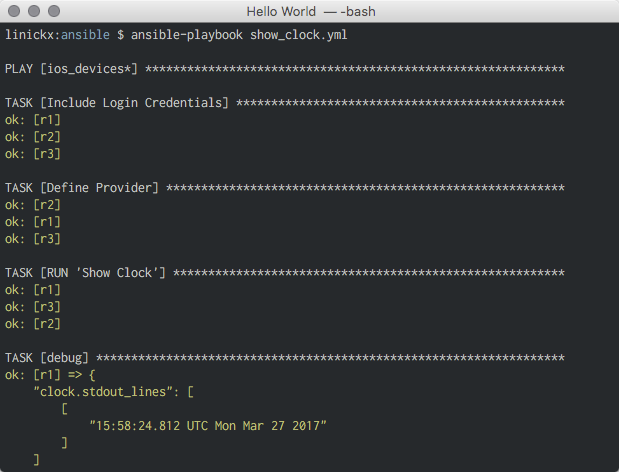- Ansible Free Download
- Ansible Check Os Version
- Ansible Download Mac Os X64
- Ansible Download For Windows
- Ansible Download Mac Os X 10 13 Download
You will need python 2.6 or greater. OS X ships with python 2.7.
You can use pip to install the python packages required for ansible. Here's how to install it if you don't have it already.
Now you can install ansible:
Simply 3 steps to install ansible on mac os x 11. Pip3 install ansible sudo mkdir -p /etc/ansible sudo nano /etc/ansible/hosts add server ip's to the hosts file web 198.20.200.211 //Replace with your client’s ip address. Check the status of the connection. Ansible all -m ping.
Nov 10, 2020 Mac Development Ansible Playbook. This playbook installs and configures most of the software I use on my Mac for web and software development. Some things in macOS are slightly difficult to automate, so I still have some manual installation steps, but at least it's all documented here. Getting started with ansible on OS X. GitHub Gist: instantly share code, notes, and snippets. Feb 23, 2019 In this tutorial we will go over steps on how to install Ansible on macOS? Mac setup and configuration via Ansible. How to install Ansible on Apple MacOS X using command line? Install ansible on macOS Mojave; Let’s get started. Install Ansible using pip command. PIP is a package manager for Python packages. Upgrade ansible to 2.0.2.0 on mac os x using pip. GitHub Gist: instantly share code, notes, and snippets.
NOTE: Maybe if I used the homebrew python packages, I wouldn't have to do all this sudo nonsense...

Set up a vagrant VM to test ansible with. Make sure you are running the latest version of Vagrant!
Edit your vagrant file, Vagrantfile to match the one in this gist.
Install your SSH public key on the vagrant box. This is simple with ssh-copy-id. Youcan install it via homebrew if you haven't already.
Copy the SSH key to your vagrant box. You will need to type the password (vagrant) at this step.
If everything went smoothly, you should be able to log in withoutbeing prompted for a password.
Add your VM's IP to the /etc/ansible/hosts file. You will need to create it. The file is included in this gist.
TODO: find out if there's another place I can store this file on my local machine that doesn't require sudo access.
Now if everything is setup correctly, you should be able to ping the vagrant box using ansible.
Hooray! Now to setup a rails stack with ansible...
Ansible is a great tool for config management on a set of remote machines. However, Ansible can be used to execute commands locally too. My uses for Ansible include writing a'playbook' (i.e. an Ansible script) to install software locally if I get a new laptop and provisioning virtual machines in amazon's EC2.In the this post you will see how to execute a one liner on set of hosts. More fun stuff will be in later posts. :-)
1. Firstly, install Ansible. Assuming you use homebrew (and if you are on a mac you really should be!) execute the following:

brew update
brew install ansible
2. Create a working directory.
mkdir ansible_wd
cd ansible_wd
Ansible Free Download

3. Within your current directory create a file called hosts and open it with your favourite editor. This hosts file will contain a list of machine names/ip addresses etc.
vim hosts
4. In hosts paste the following:
[group_name]
localhost
This means you have a group called [group_name] (change this to something sensible!) with one host in the group - localhost.
5. Assuming you have an RSA key set up , you need to paste your public key in ~/.ssh/authorized keys.
cat ~/.ssh/id_rsa.pub >> ~/.ssh/authorized_keys

6. Now you are ready to run your first Ansible command:
Make sure you have your sound on and execute the following:
ansible all -i hosts -a 'say hello ansible'
What does this do?
Ansible Check Os Version
- 'all' means execute on all hosts
- '- i' option means inventory which is your hosts file
- '-a' means you are executing an ad-hoc command on the relevant hosts.
- 'say hello ansible' is the command to be executed on every hosts. Note that on Mac OS X, say should be installed by default.
Another example to install htop locally using homebrew:

ansible group_name -i hosts -a 'brew install htop'
So you might be wondering what is the point? Why would I bother setting up Ansible to execute local commands like 'brew install htop' in a more roundabout way than simply typing the command? As mentioned at the start of the post, one useful thing you can do is add commands to an Ansible script which you can execute on any machine to install software. This will save massive amounts of time when you get your new dev machine and you can magically install everything by running one script. For me, it's open-jdk, htop, wget among other things.
Ansible Download Mac Os X64
You might wonder why can't you simply write a shell script to execute a series of steps? Well you could, but Ansible is a bit cleverer than that - it can manage state and do all sorts of crazy stuff which we will see in coming posts.
Ansible Download For Windows
In the next post we will learn how create an Ansible playbook to execute statements on remote or local machines.Ansible Download Mac Os X 10 13 Download
